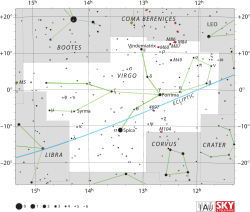Lambda Virginis

| |
| Observation data Epoch J2000.0 Equinox J2000.0 | |
|---|---|
| Constellation | Virgo |
| Right ascension | 14h 19m 06.59235s[1] |
| Declination | −13° 22′ 15.9459″[1] |
| Apparent magnitude (V) | +4.52[2] (5.00 + 5.63)[3] |
| Characteristics | |
| Spectral type | A1 V[4] (A1V + A1V)[3] |
| U−B color index | +0.12[2] |
| B−V color index | +0.12[2] |
| Astrometry | |
| Radial velocity (Rv) | −10.9[5] km/s |
| Proper motion (μ) | RA: −15.91[1] mas/yr Dec.: +28.92[1] mas/yr |
| Parallax (π) | 18.81 ± 0.10[3] mas |
| Distance | 173.4 ± 0.9 ly (53.2 ± 0.3 pc) |
| Orbit[3] | |
| Period (P) | 206.7321±0.0040 d |
| Semi-major axis (a) | 19.759±0.079 mas |
| Eccentricity (e) | 0.0610±0.0036 |
| Inclination (i) | 109.86±0.24° |
| Longitude of the node (Ω) | 196.40±0.22° |
| Periastron epoch (T) | 53,070.30±0.32 |
| Argument of periastron (ω) (secondary) | 272.28±0.46° |
| Semi-amplitude (K1) (primary) | 24.78±0.17 km/s |
| Semi-amplitude (K2) (secondary) | 27.308±0.067 km/s |
| Details | |
| λ Vir A | |
| Mass | 1.897[3] M☉ |
| Radius | 2.35[3] R☉ |
| Luminosity | 20.84±0.25[3] L☉ |
| Surface gravity (log g) | 3.97[3] cgs |
| Temperature | 8,280±200[6] K |
| Metallicity [Fe/H] | 0.0097[3] dex |
| Rotational velocity (v sin i) | 36±1[3] km/s |
| Age | 935[3] Myr |
| λ Vir B | |
| Mass | 1.721[3] M☉ |
| Radius | 1.84[3] R☉ |
| Luminosity | 12.58±0.16[3] L☉ |
| Surface gravity (log g) | 4.14[3] cgs |
| Temperature | 8,280±200[6] K |
| Rotational velocity (v sin i) | 10±2[3] km/s |
| Other designations | |
Lambda Virginis (λ Vir, λ Virginis) is a binary star system in the zodiac constellation of Virgo. With an apparent visual magnitude of 4.5, it is bright enough to be seen with the naked eye. It has the traditional name Khambalia (from old Coptic meaning 'Crooked Claw').[8] In China, 亢宿 (Kàng Xiù), meaning Neck, refers to an asterism consisting of this star, κ Virginis, ι Virginis and κ Virginis.[9] Consequently, λ Virginis itself is known as 亢宿四 (Kàngsusì, English: the Fourth Star of Neck.)
Based upon parallax measurements, the Lambda Virginis system is about 173 light years away from the Sun. It is a double-lined spectroscopic binary[10] with an orbital period of 206.7 days and an eccentricity of 0.0610. The semi-major axis has an angular size of 0.02″, which, at the distance of this system, is equivalent to a physical span of 1.050±0.007 AU. The orbit is inclined by an angle of 110° to the line of sight from the Earth. Tidal theory predicts that eventually the orbit of the stars will circularize and their rotation rates will become synchronized with their orbital motion. However, this will occur over a time scale of more than 1.2 billion years, whereas their estimated age is 935 million years.[3]
The combined spectra of the components has a stellar classification of A1V,[4] which matches an A-type main sequence star. The two components have magnitudes of +5.0 and +5.6.[3] Both components are Am stars,[10] indicating they appear chemically peculiar. The primary appears to be rotating around 3.5 times faster than the secondary.[3]
References
- 1 2 3 4 van Leeuwen, F. (2007), "Validation of the new Hipparcos reduction", Astronomy and Astrophysics, 474 (2): 653–664, arXiv:0708.1752
 , Bibcode:2007A&A...474..653V, doi:10.1051/0004-6361:20078357.
, Bibcode:2007A&A...474..653V, doi:10.1051/0004-6361:20078357. - 1 2 3 Mermilliod, J.-C. (1986), "Compilation of Eggen's UBV data, transformed to UBV (unpublished)", Catalogue of Eggen's UBV data, SIMBAD, Bibcode:1986EgUBV........0M.
- 1 2 3 4 5 6 7 8 9 10 11 12 13 14 15 16 17 18 19 Zhao, M.; et al. (April 2007), "Physical Orbit for λ Virginis and a Test of Stellar Evolution Models", The Astrophysical Journal, 659 (1): 626−641, arXiv:astro-ph/0612135
 , Bibcode:2007ApJ...659..626Z, doi:10.1086/511415.
, Bibcode:2007ApJ...659..626Z, doi:10.1086/511415. - 1 2 Houk, N.; Smith-Moore, M. (1988), Michigan Catalogue of Two-dimensional Spectral Types for the HD Stars, 4, Bibcode:1988MSS...C04....0H.
- ↑ Wilson, R. E. (1953), General Catalogue of Stellar Radial Velocities, Carnegie Institute of Washington, D.C., Bibcode:1953GCRV..C......0W.
- 1 2 Abt, Helmut A.; Morrell, Nidia I. (July 1995), "The Relation between Rotational Velocities and Spectral Peculiarities among A-Type Stars", Astrophysical Journal Supplement, 99: 135, Bibcode:1995ApJS...99..135A, doi:10.1086/192182.
- ↑ "lambda Vir -- Spectroscopic binary", SIMBAD Astronomical Database, Centre de Données astronomiques de Strasbourg, retrieved 2016-09-08.
- ↑ Allen, R. H. (1963), Star Names: Their Lore and Meaning (Reprint ed.), New York, NY: Dover Publications Inc., p. 472, ISBN 0-486-21079-0.
- ↑ (Chinese) AEEA (Activities of Exhibition and Education in Astronomy) 天文教育資訊網 2006 年 6 月 28 日
- 1 2 Monnier, J. D.; et al. (February 2004), "First Results with the IOTA3 Imaging Interferometer: The Spectroscopic Binaries λ Virginis and WR 140", The Astrophysical Journal, 602 (1): L57−L60, arXiv:astro-ph/0401268
 , Bibcode:2004ApJ...602L..57M, doi:10.1086/382213.
, Bibcode:2004ApJ...602L..57M, doi:10.1086/382213.